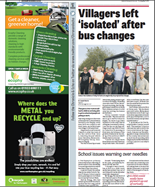Predictable, Repeatable, and Ad-hoc page layouts
The definitions
Predictable page layout
Such page layout consists of the shapes that are "predictable" on their own, therefore, having a closed number of variations and all the variations are used again and again on the pages of the paper product. On the following screenshot, after the confirmation of the editorial staff, the left page was considered as a predictable layout. Breaking it down by articles, comes out that the top shape is suitable for the three-decks headline, a central image, a caption below the image, and no pull quote. The bottom shape is suitable for an article with a single deck headline, shorter text and a pull quote.
Anyhow, a mandatory condition for the predictable layout is that both the number of articles on the editorial layer and the space, left after the ads are placed on page, must be predictable.
Repeatable page layout
A page layout is considered as repeatable if it can be used with different images and text content (within a predefined range of image sizes and text length).
Ad-hoc pagelayout
Such page layout is "one-time" use, created ad-hoc and tied to the given content. It is likely unsuitable for any other images or text content. This makes such layout as "unrepeatable" or "unlikely repeatable". An example of such page layout is the page on the right side.
|
|
Why the page on the left is considered as predictable and repeatable?
On the previous screenshot, the layout of the page of the left is considered as "predictable" and repeatable because it satisfies the following conditions:
•The position and the dimensions of the ad are predictable - the ad (or more vertically stacked ads) will always start on top of the page or on top margin, it will run down till the bottom margin or the bottom of the page, and it will have always the same width. Please note that the given page layout can be used on odd and on even pages - you do not need to create two library objects, one for the odd and another for the even pages, but you can use the same object for both.
•The position and the dimensions of the vertical filler are predictable. Therefore, the empty space on the page would be predictable.
Why the page on the right is considered as ad-hoc and unrepeatable?
On the previous screenshot, the layout of the page of the right is considered as "ad-hoc", and therefore "unrepeatable" because of the following reasons:
•The clipped images, in general, are not predictable. The clipping path can be any, and it determines also the flow of the text. It means that with different pictures, some text columns can become too short or cut in wrong position.
•The text content also seems to be "ad-hoc" and adapted to the current image.
•The caption position and width is tied to the current clipping path.
Note: although you can create an ad-hoc layout and put it into an object library, and therefore Fred will be able to auto-paginate such page with the same article, it is very likely that it won't work with any other image and any other text.
Turning "ad-hoc" layouts into "predictable"
Although it probably doesn't make sense, you can create more variants of an ad-hoc layout, suitable for the closed list of images with different clipping paths and articles with different text content. In the real life, a small minority of ad-hoc layouts can be turned into predictable, but you can always try your luck.


